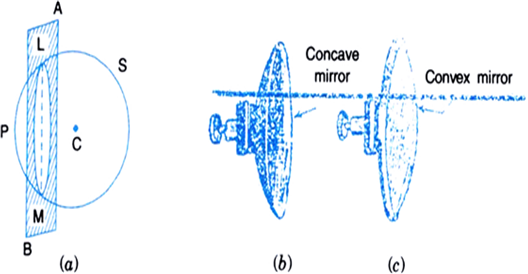Define the following terms in connection with reflection of light:
Incident ray, reflected ray, point of incidence, normal, angle of incidence and angle of reflection.
Incident ray: The ray of light that falls on the reflecting surface is called incident ray.
Reflected ray: The ray that bounces back from the reflecting surface, after reflection from it is called reflected ray.
Point of incidence: The point at which the incident ray strikes the reflecting surface is called point of incidence.
Normal: The line which is drawn perpendicular to the reflecting surface, at the point of incidence is called the normal at that point.
Angle of incidence: It is the angle between the incident ray and the normal to the reflecting surface at the point of incidence. It is denoted reflection by i.
Angle of reflection: It is the angle between the reflected ray and the normal to the reflecting surface at the point of incidence. It is denoted by r.
In the past there has been a debate over the nature of light. If, it exhibits wave nature or particle nature. And, inorder to establish the nature of light, various theories about the nature of light have been proposed from time to time.
Some of the main theories are as follows:
1. Corpuscular theory of light: Newton, the great among the greatest, proposed in 1675 A.D. that light consists of tiny particles called corpuscles which are shot out at high speed by a luminous object. This theory could explain the reflection, refraction and rectilinear propagation of light.
2. Wave theory of light wave: In 1678, Dutch scientist Christian Huygens, suggested that light travels in the form of longitudinal waves just as sound propagates through air. Later on, Fresnel and Young showed that light propagates as a transverse wave. This successfully explained the reflection, refraction as well as interference, diffraction and polarisation of light waves.
3. Electromagnetic nature of light waves: In 1873, Maxwell suggested that light propagates as electric and magnetic field oscillations. These are called electromagnetic waves which require no medium for their propagation. Also, these waves are transverse in nature.
4. Planck’s quantum theory of light: According to Max Planck, light travels in the form of small packets of energy called photons. In 1905, Albert Einstein used this theory to explain photoelectric effect (emission of electrons from a metal surface when light falls on it).
5. De-Broglie's hypothesis: De Broglie suggested that light has a dual nature, i.e., it can behave as particles as well as waves.
So, we see that in phenomena like interference, diffraction and polarisation, light behaves as a wave while in photoelectric effect, it behaves a particle.
Ray of light: The direction or path along which light energy travels in a medium is called a ray of light. It is represented by a straight line with an arrow marked on it.
Beam of light: A group of light rays is called a beam of light. A beam of light may be parallel, convergent or divergent, as shown in Fig.
Fig. Different beams of light
The rays from a distant light source (such as the sun) are parallel to each other, they constitute a parallel beam. In a convergent beam, the rays proceed towards a point. In a divergent beam, the rays proceed away from a point.
Real image: If a beam of rays starting from a point source of light, after reflection or refraction, actually converges to a point, then the second point is called the real image of the first.
A real image is formed due to actual intersection of rays, so it can be obtained on a screen.
It is usually inverted.
e.g., The images formed on a cinema screen are real images.
Virtual image: If a beam of rays starting from a point source of light, after reflection or refraction, appears to diverge from another point, then the second point is called the virtual image of the first.
A virtual image is not formed due to the actual intersection of the rays, so it cannot be obtained on a screen.
Virtual image is usually erect.
e.g. The image of our face in a looking glass is a virtual image.
Spherical mirror: A spherical mirror is a mirror whose reflecting surface is a part of a hollow sphere.
In Fig, S is a hollow glass sphere being cut by a plane AB. The section LPM of this spherical shell cut by the plane, forms a part of the sphere and is known as spherical surface. If either side of this spherical surface is silvered, we get a spherical mirror.
Spherical mirrors are of two types:
(i) Concave mirror: A spherical mirror is concave if it is silvered on the outer bulged surface and reflects light from the inner hollow surface [Fig.(b)].
Fig.(a) A spherical shell cut by a plane surface, (b) concave mirror, and (c) convex mirror.
(ii) Convex mirror: A spherical mirror is convex if it is silvered on the inner hollow surface and reflects light from the outer bulged surface.[Fig. (c)]
